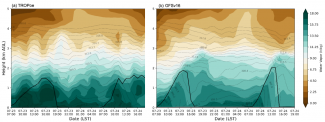The next operational implementations of the Global Forecast System (GFS) and Global Ensemble Forecast System (GEFS) are not scheduled until 2024, but work is underway to code and test a number of upgrades to these modeling systems. While innovations are planned in all aspects of the end-to-end system, the DTC has been particularly involved in supporting the development and improvement of the physics suite as a member of the Unified Forecast System (UFS) Research-to-Operations (R2O) physics subproject.
The GFS and GEFS are configurations of the UFS used for operational numerical prediction. Their 2024 operational implementations will use the Common Community Physics Package (CCPP) for the first time. To prepare for this, a CCPP-based configuration of the GFS using the current operational physics suite was created to serve as a baseline for future development. DTC conducted a thorough assessment of this baseline using process-oriented methods to highlight physical relationships responsible for forecast biases. For example, examination of the relationship between precipitable water and precipitation suggested there is still room for improvement in triggering of deep convection over the central and eastern contiguous United States (CONUS). Additionally, a case study was used for the in-depth examination of a known low bias in convective available potential energy (CAPE) over the CONUS, which suggested a problem with the representation of soil moisture, resulting in reduced evaporation and excessively dry planetary boundary layer (PBL; figure below).
On top of this baseline, physical parameterizations were added to or improved in the CCPP, and then assessed individually and incrementally to determine their suitability for the upcoming implementation. The DTC staff supported physics developers in adding their innovations to CCPP, conducting experiments in one- and three-dimensional configurations, and analyzing results from their own runs as well as from runs conducted by developers and the NOAA Environmental Modeling Center (EMC).
DTC contributed to a number of evaluations of alternate gravity wave drag (GWD) parameterization configurations, including the assessment of the small-scale orographic GWD implemented in the CCPP by Michael Toy of NOAA Global Systems Laboratory (GSL). For example, DTC contributed kinetic-energy spectra evaluations of a C384 (approximately 25-km grid spacing) run conducted by EMC and C768 (approximately 13-km grid spacing) runs conducted by GSL that ascertained the new configuration did not adversely affect the canonical distribution of energy among various scales of motion. DTC also evaluated innovations in the surface layer, PBL and convective representations, and stochastic physics provided by Jongil Han of EMC and Lisa Bengtsson of NOAA Physical Sciences Laboratory. These evaluations, which on more than one occasion revealed bugs that were subsequently fixed by developers, contributed to the decision to adopt the innovations for the latest GFS/GEFS prototype, dubbed P8.
DTC testing and evaluation also identified innovations that are not yet ready for transition to operations. In particular, evaluations of multiple versions of the Rapid Radiative Transfer Model for Global Climate Models (RRTMG-Parallel; RRTMGP) radiation scheme revealed that this new radiative scheme, or its coupling with other physical processes, produces excessively warm temperatures over Antarctica. The DTC conducted an in-depth investigation using the CCPP Single-Column Model to simulate the Department of Energy Atmospheric Radiation Measurement West Antarctic Radiation Experiment case. Results suggest that the problem seen in the three-dimensional tests may stem from interactions between RRTMGP and the land-surface model and that RRTMGP is more responsive to low-level clouds than the currently operational RRTMG scheme, indicating a need for further investigation.
The integration of DTC testing and evaluation activities with development activities under the auspices of the UFS and UFS-R2O physics working groups represents a new and successful paradigm in cooperation. DTC assessed innovations at a rapid pace and in close collaboration with developers, providing actionable information to assist EMC and project leads in determining physics configurations for the upcoming GFS and GEFS implementation.
